Natural fabric dyeing

Fabric dyed with avocados. (Photo by Sage Yathon)
What you will need:
- a large pot, a spoon, a stovetop
- 100% cotton fabric or clothing
- white vinegar
- avocados, yellow onions or black beans
Preparing your fabric or clothing
1. Start by gathering white clothing or fabric that you’d like to dye. It is important that the clothing or fabric is 100% cotton.
2. Machine or hand wash your materials with hot water and detergent.
3. No need to dry the fabric, as the next step is to “mordant” the fabric — prepare it to absorb colour. See below.
Vinegar mordant method
Add one-part white vinegar to three parts water in the largest pot you have and bring to a boil. Add fabric and fully submerge in the water. Let simmer with lid off for one hour. Remove and rinse under running water. Your fabric is now ready for the dye bath.
Making the dyes
Avocado skins and pits make a peach/pink colour, yellow onion skins a make yellow/orange colour, and black beans make a purple/blue colour. If you don’t have any of these, look for something in your kitchen or backyard that might produce colour. You can even used pine cones. Every time you make dyes, you may get different results. Embrace the uncertainty!
Extracting dye from avocados

Fabric dyed with avocados. (Photo by Sage Yathon)
Take three avocados and scoop out the green flesh. Take the skins and the pits and put them in a large pot with just enough water to cover them. Bring to a boil and reduce the heat to a simmer. Let simmer with lid off for one hour. Turn off the heat and let it cool. Strain out all the pieces so that you only have your liquid dye left in the pot.
Extracting dye from yellow onions

A toddler shirt dyed with yellow onion skins. (Photo by Sage Yathon)
Use three to five onions. Peel the onions, as you will only be using the skins. Add only the skins to a large pot, fill with enough water to cover. Bring to a boil, reduce heat to a simmer. Let simmer with lid off for one hour. Turn off the heat and let it cool. Strain out all of the pieces so that you only have liquid dye left in the pot.
Extracting dye from black beans

A shirt dyed with black beans. (Photo by Sage Yathon)
Make sure you are using dry black beans, not canned. Pour dry beans into a pot or large bowl and add enough cold water to cover the beans. Let sit overnight or for at least eight hours. Strain the beans out.
Dyeing clothing or fabric
Using your largest pot, add your dye and bring to a boil. Add your clothing or fabric, but wet it first if it is no longer wet from the previous step. Add a bit of water if needed to ensure the fabric is fully submerged. Reduce to a simmer with lid off for one hour, and let cool. Remove the fabric or clothing using gloves, rinse in cold water and hang to dry. Let the fabric or clothing fully dry, give it a day to set, and then machine wash on cold setting, and dry as you normally would.
Leaving clothing and fabrics in the dye bath for longer will give you deeper colours. I have learned that patience is all part of the process. Colours will be darker when wet and lighter when dry. Colours may fade a little after being washed. It takes some trial and error, so be kind to yourself and manage your expectations. This is meant to be fun, and there is no such thing as a failed art project.




